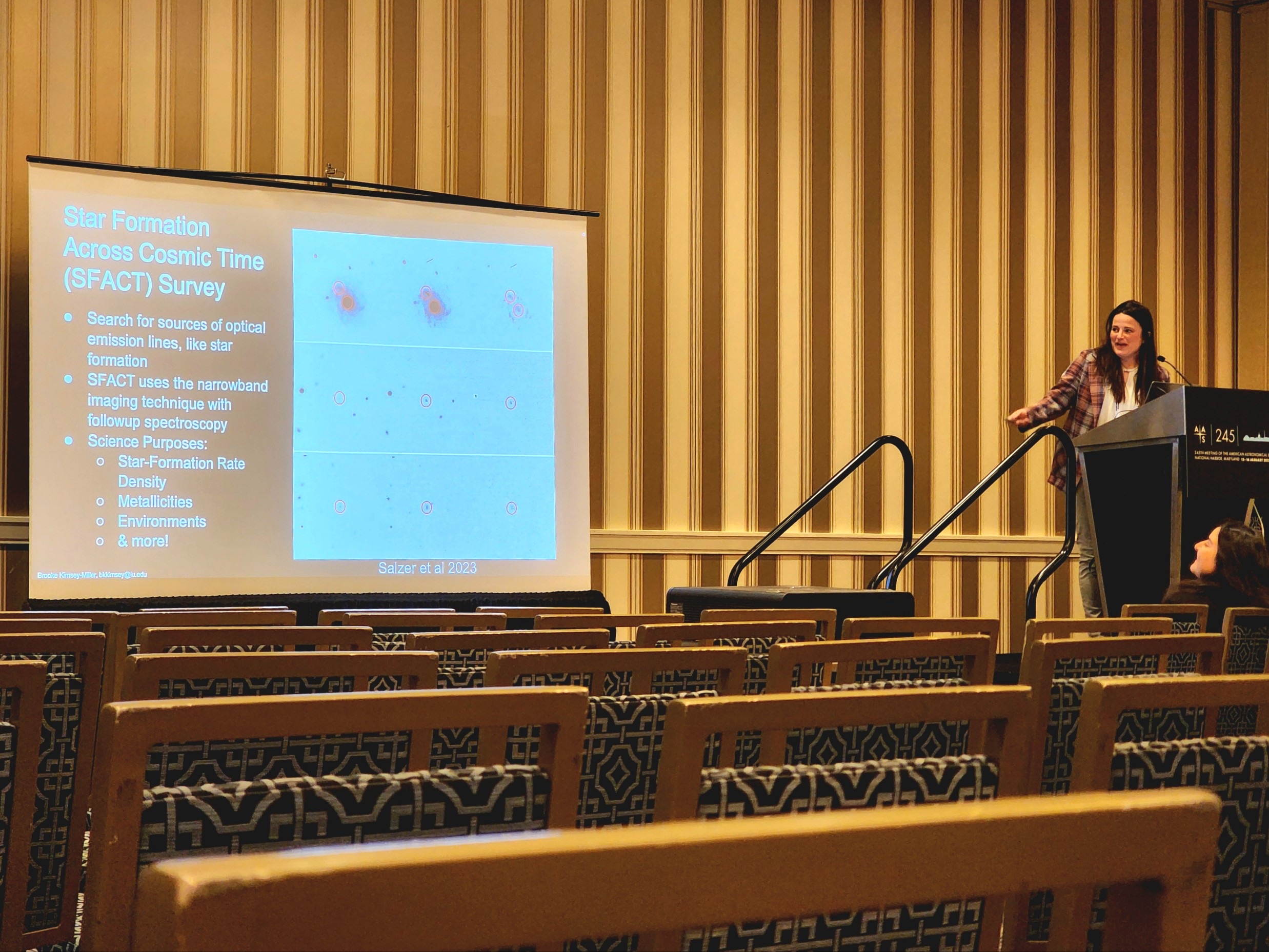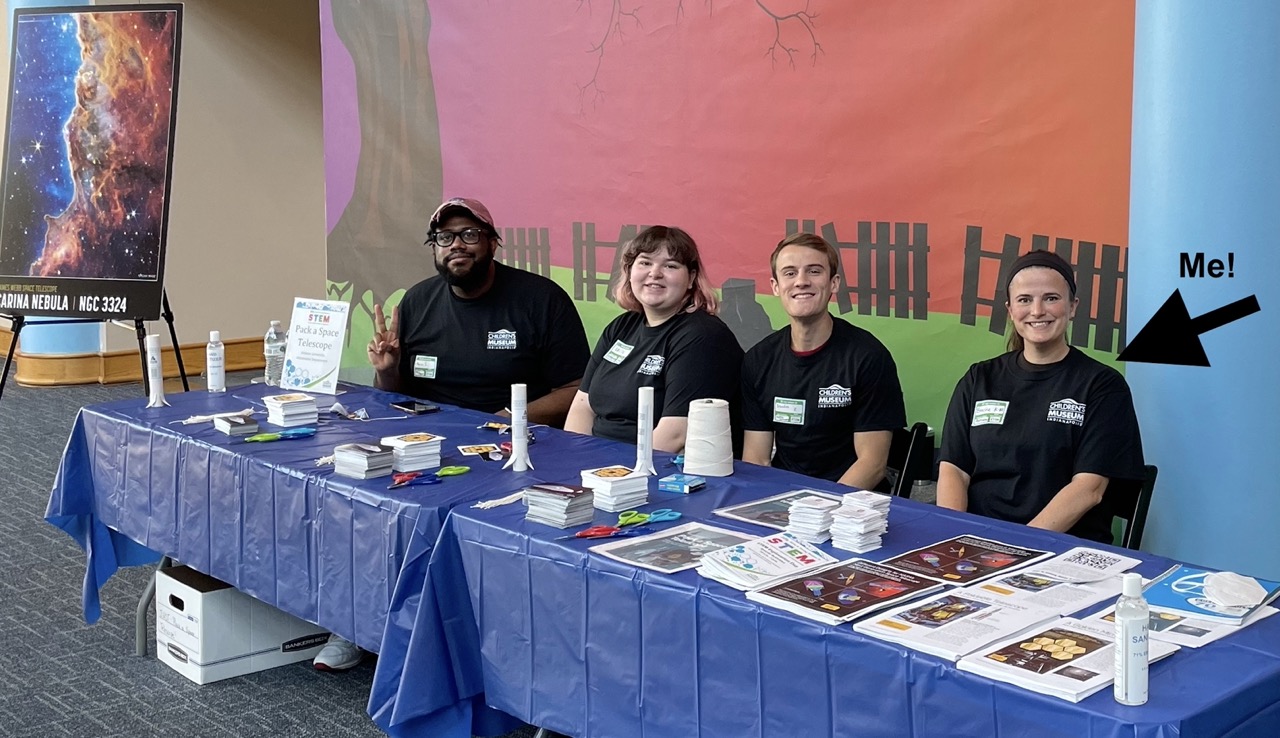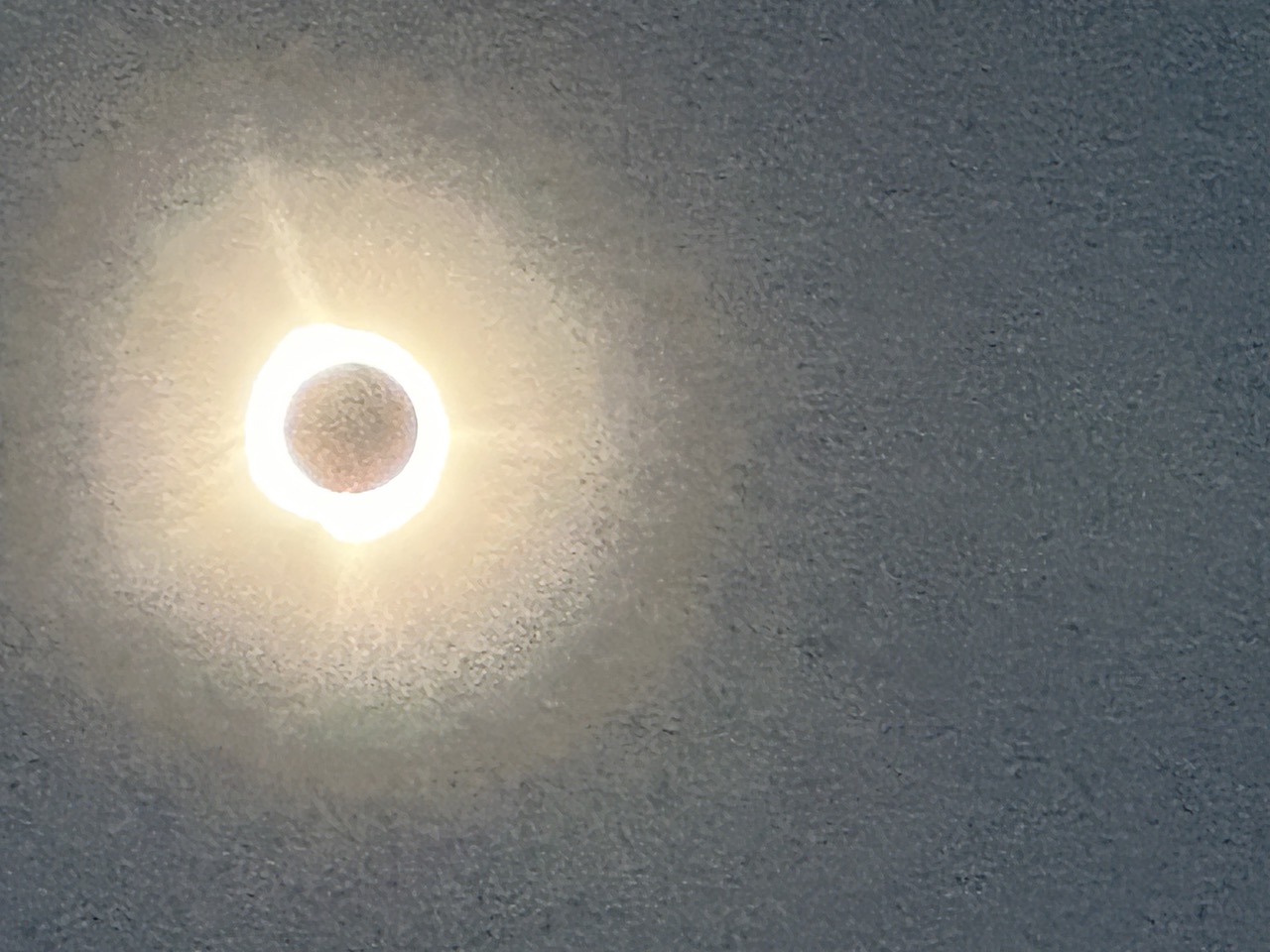Research

Summary
You may have heard the phrase “We are all stardust.” This is absolutely true! Most elements, including oxygen,
are created in stars and redistributed when the more massive stars die. Galaxies can have 100s of billions of stars,
and those galaxies that are currently creating lots of stars are called star-forming galaxies (SFGs). The more stars in a galaxy that are
created and die, the more oxygen that is created and redistributed within that galaxy. The environment that a galaxy lives in can impact
how many stars the galaxy makes. When a galaxy interacts with another galaxy it can trigger creating more stars. By studying the environment
of SFGs, we study how the elements that make-up ‘us’ and all living things came to be.
The Star Formation Across Cosmic Time (SFACT) Survey
I've been a collaborator on the SFACT survey since Fall 2021. SFACT is a narrowband imaging survey that searches for sources
of optical line emission, such as star formation. Using the One Degree Imager on the WIYN 3.5m telescope, it detects emission-line
galaxies (ELGs) by identifying objects with excess flux in three specially designed narrowband (NB)
filters. The filters were designed to span a broad wavelength range and not overlap in wavelength.
This enables the SFACT survey to detect SFGs in discrete redshift intervals
out to z ∼ 1. The survey has a median sample depth of r ∼ 22.5, with the faintest objects reaching
r ∼ 25.8 (Salzer et al. 2023;
Sieben et al. 2023).
Follow-up spectroscopy is conducted using the
multi-fiber positioner Hydra, also on the WIYN 3.5m (Salzer et al. 2023;
Carr et al. 2023).
The Environments of Green Pea Galaxies
Originally discovered by citizen scientists, Green Pea galaxies (GPs) are compact, extreme SFGs
with low metallicities, low to intermediate masses, and high star formation rates (SFRs) that are
found at intermediate redshifts (Cardamone et al. 2009).
We applied the clustering analysis developed by Brunker et al. (2022)
to determine the local
galactic environments of 18 GPs ( Kimsey-Miller et al. 2024).
We found that the Hα Dot GPs typically reside
in low-density environments, in agreement with other authors (Cardamone et al. 2009;
Brunker et al. 2022).
We interpreted the low-density environments of the Hα Dot GPs to indicate that major mergers
and interactions with other galaxies do not appear to drive the star formation activities within
these extreme starbursts.
The Environments of SFACT Galaxies
The majority of SFACT galaxies are star forming. Determining whether the environment drives
the star formation activity within these galaxies is important to the overall field of galaxy evolution.
We utilize a visual representation and three density
estimators as a measurement of environment. We find a clear picture for each density estimator over four preliminary fields.
SFACT galaxies are found in a range of environments. However, they tend to be found in lower
density environments than the redshift survey comparison sample. We perform statistical tests
on our environmental estimators. In nearly all cases, we are able to reject the hypothesis that the
SFACT star-forming galaxies and redshift survey comparison sample of galaxies are drawn from the
same population. To complete the work, we are currently in the process of acquiring the necessary
spectroscopic data to perform the environmental analysis on all six fields.
Outreach

I love getting to take the time to share the amazing wonders of the universe with diverse audiences. I've presented to amateur astronomers,
kids, and even in a local factory. Through my association with the Department of Astronomy at Indiana University, I have been fortunate
enough to organize and/or participate in over 70 outreach events!
I was the graduate student Outreach Coordinator in the Department of Astronomy at Indiana University for two years (2021-2023).
One of the activities I am most proud of during my tenure includes helping to organize the university-wide Science Fests of 2021
and 2022, where
the university had a record number of visitors. The University also had to protect out attendees, who at the time, could not be vaccinated
against COVID-19. Another activity I am proud of is the Department's first attendance at a STEM festival at the world's largest
children's museum, the Children's Museum of Indianapolis (pictured above).
Teaching

I enjoy getting the opportunity to teach about the wonders of the Universe. I have taught a variety of courses, from the solar
system to stars and galaxies. I have also been an associate instructor, learning from the excellent faculty in the Department of
Astronomy.
Instructor of Record
A105: Stars and Galaxies, Summer 2023
A100: The Solar System, Summer 2022
A107: The Art of Astronomy, Summer 2021
Associate Instructor
A103: Search for Life in the Universe, Fall 2020
A105: Stars and Galaxies, Spring 2019, 2020, 2021
A107: The Art of Astronomy, Fall 2019
Guest Lecturer
A115: Birth and Death of the Universe, Spring 2023
About Me

Hi, I’m Brooke Kimsey-Miller (she/her) and I’m a doctoral candidate at Indiana University in the Department of Astronomy.
I work on the Star Formation Across Cosmic Time (SFACT) survey and utilize this survey to explore
the environments of star-forming galaxies. I received my bachelor's degrees in Math, Physics, and Astronomy & Astrophysics at IU.
I’m a 21st Century Scholars alumna, an Indiana Space Grant Consortium Doctoral Fellow, and a College of Arts and Sciences
Dissertation Research Fellow.
Contact
Elements
Text
This is bold and this is strong. This is italic and this is emphasized.
This is superscript text and this is subscript text.
This is underlined and this is code: for (;;) { ... }. Finally, this is a link.
Heading Level 2
Heading Level 3
Heading Level 4
Heading Level 5
Heading Level 6
Blockquote
Fringilla nisl. Donec accumsan interdum nisi, quis tincidunt felis sagittis eget tempus euismod. Vestibulum ante ipsum primis in faucibus vestibulum. Blandit adipiscing eu felis iaculis volutpat ac adipiscing accumsan faucibus. Vestibulum ante ipsum primis in faucibus lorem ipsum dolor sit amet nullam adipiscing eu felis.
Preformatted
i = 0;
while (!deck.isInOrder()) {
print 'Iteration ' + i;
deck.shuffle();
i++;
}
print 'It took ' + i + ' iterations to sort the deck.';
Lists
Unordered
- Dolor pulvinar etiam.
- Sagittis adipiscing.
- Felis enim feugiat.
Alternate
- Dolor pulvinar etiam.
- Sagittis adipiscing.
- Felis enim feugiat.
Ordered
- Dolor pulvinar etiam.
- Etiam vel felis viverra.
- Felis enim feugiat.
- Dolor pulvinar etiam.
- Etiam vel felis lorem.
- Felis enim et feugiat.
Icons
Actions
Table
Default
| Name |
Description |
Price |
| Item One |
Ante turpis integer aliquet porttitor. |
29.99 |
| Item Two |
Vis ac commodo adipiscing arcu aliquet. |
19.99 |
| Item Three |
Morbi faucibus arcu accumsan lorem. |
29.99 |
| Item Four |
Vitae integer tempus condimentum. |
19.99 |
| Item Five |
Ante turpis integer aliquet porttitor. |
29.99 |
|
100.00 |
Alternate
| Name |
Description |
Price |
| Item One |
Ante turpis integer aliquet porttitor. |
29.99 |
| Item Two |
Vis ac commodo adipiscing arcu aliquet. |
19.99 |
| Item Three |
Morbi faucibus arcu accumsan lorem. |
29.99 |
| Item Four |
Vitae integer tempus condimentum. |
19.99 |
| Item Five |
Ante turpis integer aliquet porttitor. |
29.99 |
|
100.00 |




